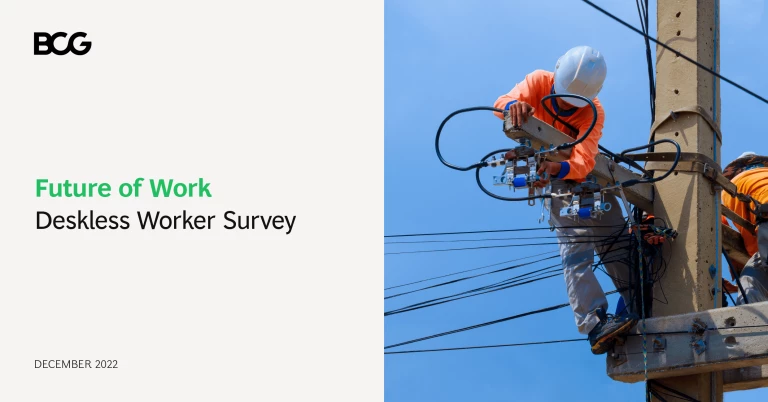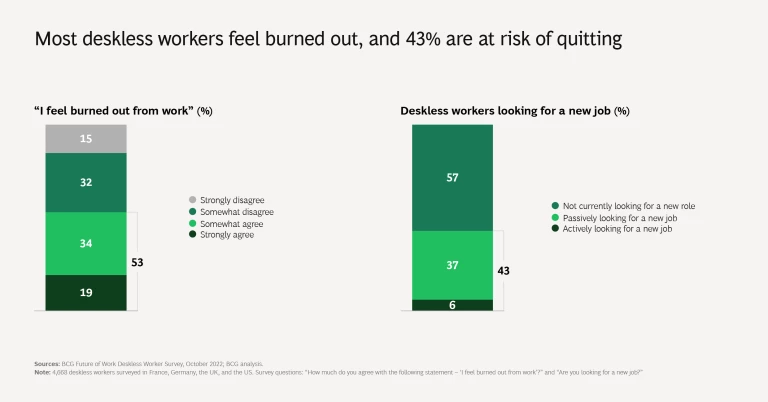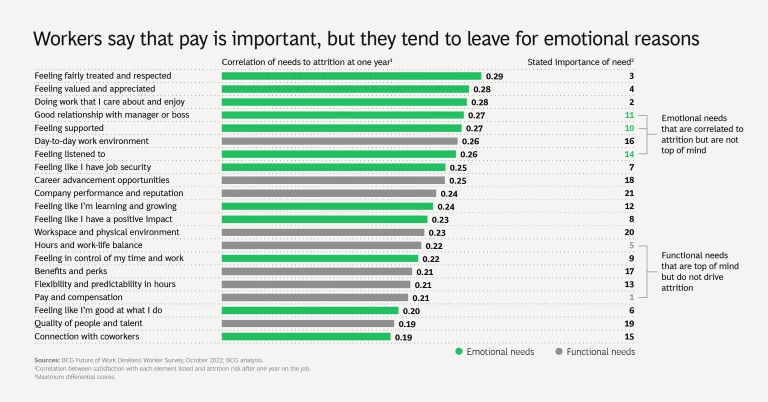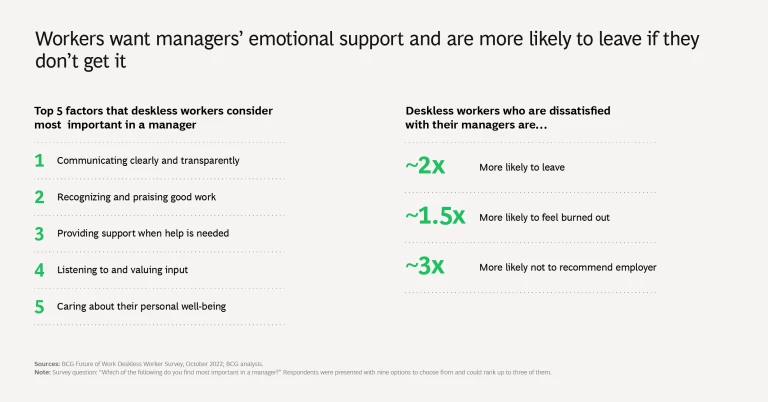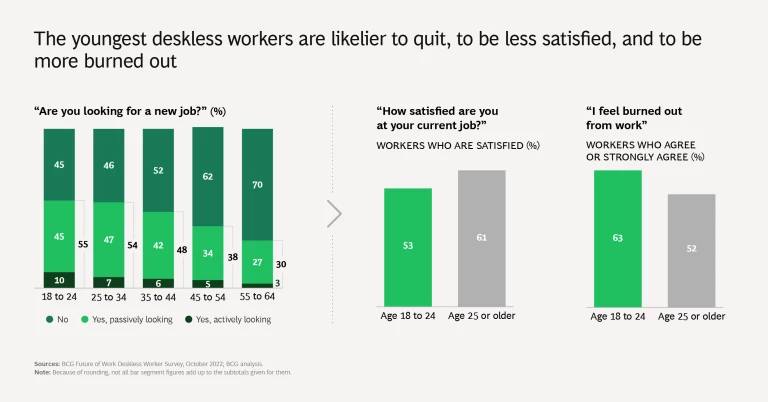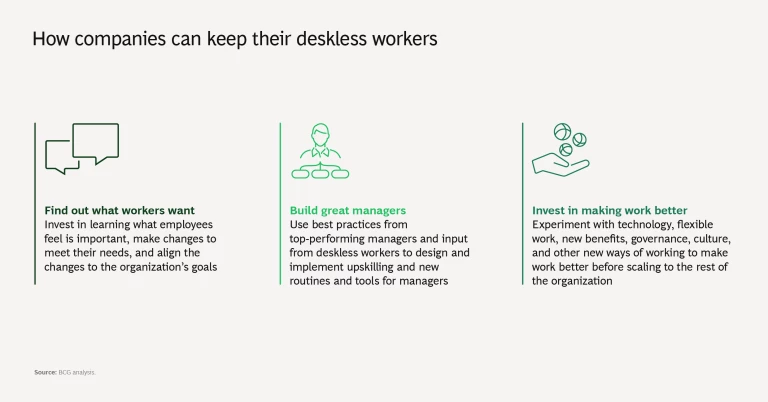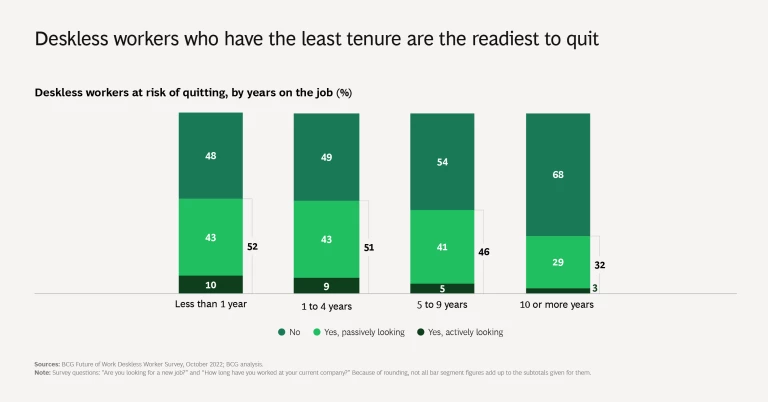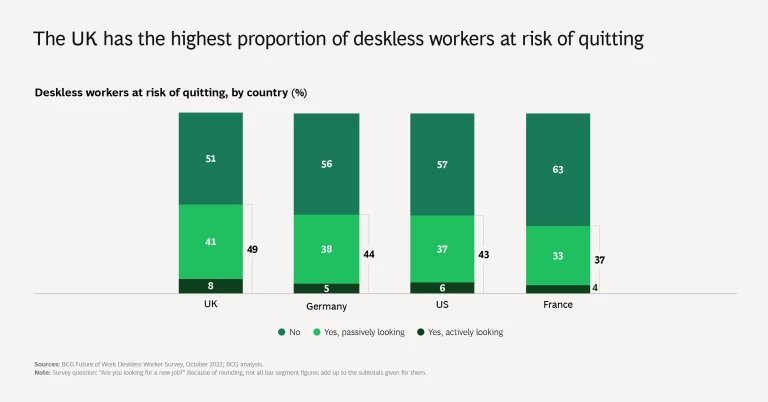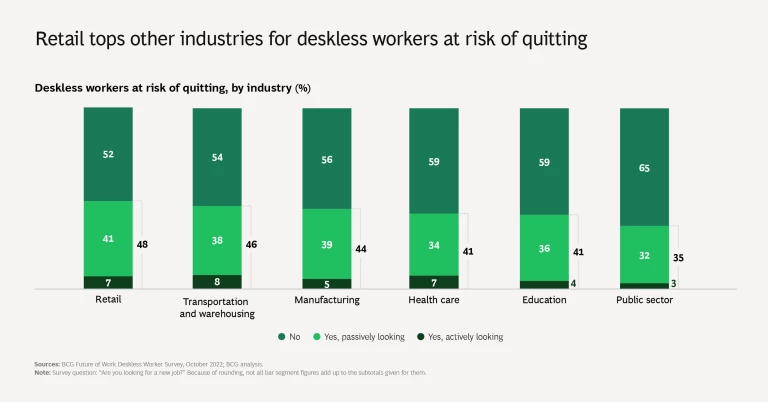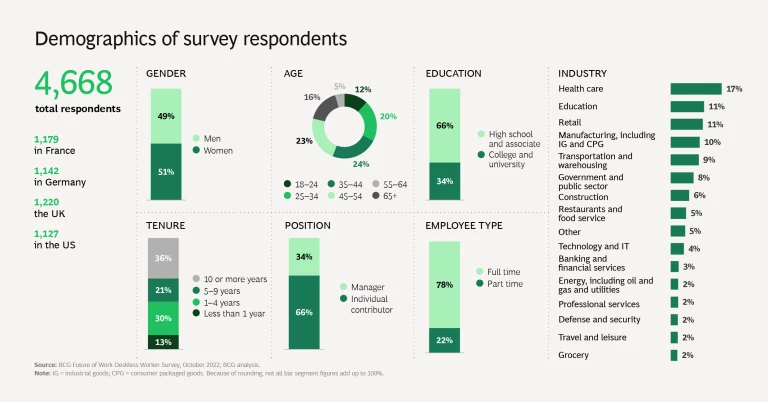At a time of massive labor shortages in industries that rely on factory workers, nurses, cashiers, restaurant servers, teachers, call-center operators, truck drivers, and other “deskless workers,” more than four in ten of these job holders are at risk of quitting—and pay isn’t the reason why.
Deskless workers in health care , retail, manufacturing, hospitality and logistics, and many similar industries represent 70% to 80% of the world’s labor force. While many people with office jobs switched to working remotely during the height of the COVID-19 pandemic, most deskless workers remained onsite. Now, more than half of them say that they are burned out, and 43% are either actively or passively looking for a new job, according to BCG’s latest survey of deskless workers.
The primary reason that deskless workers look for a new job, our survey found, is not because of unsatisfactory compensation but because their emotional needs are not being met. When members of this workforce group don’t feel respected, appreciated, treated fairly, or valued at work, they are willing to walk.
The findings are part of BCG’s research on the future of work , culled from a survey of more than 4,600 deskless workers in France, Germany, the UK, and the US. The respondents were almost evenly split between men and women, and they differed widely in age, level of seniority and job experience, and employment status.
Meeting Emotional Needs Is Key to Keeping Employees Onboard
Conventional wisdom holds that deskless workers’ pay determines their sentiments about their jobs—and when asked, deskless workers themselves say that compensation is the aspect of their jobs that matters most to them. But our analysis of this group shows that when deskless workers consider leaving, the primary factors are emotional. In fact, eight of the top ten factors that motivate deskless workers to quit involve emotional rather than functional needs. At the top of that list: feeling fairly treated and respected, feeling valued and appreciated, doing work that’s meaningful and enjoyable, and having a good relationship with a manager or boss.
Emotional factors are not the only workplace factors that deskless workers care about. Among the top ten considerations that contribute to a decision to leave a job are day-to-day work environment, opportunities for career advancement, and employer performance and reputation.
Younger Workers and ‘Quick Quitting’
Gen Z workers are by far the most eager to pursue a job change. Nearly two-thirds (63%) of 18- to 24-year-old deskless workers say that they feel burned out from work, and 55% are either actively looking for a new job or would consider switching if the right opportunity came along. Younger workers are substantially more likely than their older counterparts to be on the lookout for work elsewhere. By comparison, only 30% of deskless workers who are 55 or older say that they are job hunting, and 38% of deskless workers who are 45 to 54 say so.
The phenomenon of workers leaving a new job after a relatively short period of time has come to be known as “quick quitting.” Our data confirms that the quick-quitting trend is most prevalent among deskless workers who have the least amount of time on the job. Among deskless workers, 52% of those whose tenure is less than 12 months are either actively or passively job hunting.
Attitudes Differ by Geography and Industry
Deskless workers’ feelings about burnout and about quitting their jobs differ depending on their location and industry. Of the four countries in our survey, the UK has the largest portion of people in deskless jobs who say that they are open to a new opportunity—49%, including 8% who are actively looking and 41% who are passively looking for work.
In Germany, 43% of deskless workers are looking for a different job, 38% of them passively and 5% actively. In the US, 6% are job-searching actively and 37% passively. The situation in France appears to be the least volatile, with 4% of deskless workers actively searching for new employment and 33% looking more casually.
At the height of the pandemic, the health care industry and the public sector were among the industries that experienced the fewest layoffs or reduced work schedules . Nurses, teachers, and other deskless workers in those sectors continued to work, often under severely challenging conditions. This may explain why a disproportionate number of those workers now feel burned out and ready to quit. In health care, 41% of deskless workers are either actively (7%) or passively (34%) looking; among education providers, 4% are actively looking and 36% are passively looking.
Other industries at high risk of employee loss include retail, transportation and warehousing, and manufacturing.
What Employers Should Do
When deskless workers quit, employers lose a lot more than just the time and money it takes to replace them and get new hires up to speed in their roles. If enough top performers follow more attractive offers out the door, their departure can leave an organization without the quality and quantity of talent it needs to carry out strategic plans and deliver for its customers and other stakeholders.
Our survey findings offer clues about how employers can retain deskless workers, starting with understanding what the workers see as important and then meeting those needs.
Find out what workers want. The survey findings clearly indicate that deskless workers overall want the functional basics of a good job, including competitive pay and acceptable work-life balance, and the emotional benefits of feeling valued, recognized, and respected, doing work they enjoy, and having a positive relationship with their manager. What deskless workers at any individual organization want may be slightly different, however—and the only way to know is to ask. Invest in finding out through surveys, focus groups, and one-on-one conversations. Then use those insights to adjust practices to meet deskless workers’ needs while also ensuring that any new practices align with strategies and policies for the entire workforce, including office-based and remote workers.
Build great managers. Managers are the glue that binds all workers to their jobs and to the organization. Our research shows that deskless workers who are dissatisfied with their managers are 50% more likely to feel burned out, three times more likely not to recommend their employer as a place to work, and twice as likely to leave. Organizations must ensure that their managers have the capabilities they need to deliver a great work experience. Companies that have successfully done so have identified top-performing managers, found out how they work, engaged those managers to teach their peers, and incorporated better ways of working into day-to-day routines. Great managers may not be able to stop active job seekers from looking, but they can keep passive job seekers in the organization.
Invest in making work better. Just as companies commit to investing when they roll out new products or enter new markets, they must dedicate real effort to making work better for deskless workers. After an organization identifies potential changes to explore as possible ways to improve work, it must invest in the technology, upskilling, governance, and other enablers needed to support the new practices; then it must pilot and make necessary adjustments before rolling out and scaling the workplace changes. Investments don’t end there. If younger workers with less time on the job are the group most inclined to leave, employers need to invest in improving onboarding and career planning so that the people who represent the future of their workforce feel connected to and engaged with the organization, knowing that they have the attention and support of managers who can help them thrive even before they walk through the door.
Organizations must look beyond what deskless workers say is important in a job to understand the factors that may actually keep them from leaving in search of something better. By reading between the lines of what people say and do, forward-thinking employers can restructure work to provide members of this vital sector of the global workforce the support they crave. Companies should take the time to understand deskless workers’ true needs, build great managers, and work together with their employees to identify and invest in scaling best practices that truly make work better.




